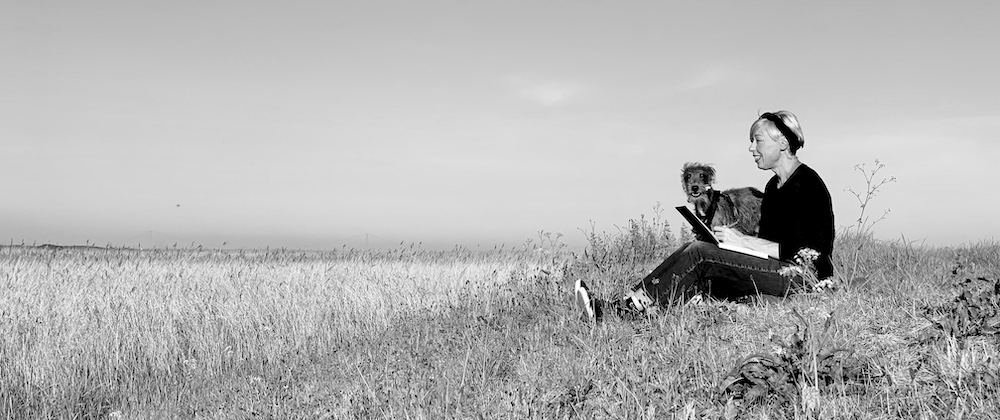Those who feel an obsessive desire to become an artist when young may eventually realise that art is a voyage of self discovery. To make real a creative dream as a visual artist in their own studio they may have feelings of triumph pleasure or satisfaction in a newly finished work only to realise upon completion that the painting drawing or print has posed another question to be answered by the next work. This process can be an important factor in an artist’s future progress towards finding out who they are as a person and what kind of artist they are to become.
Although not from an artistic family, Deborah Grice's father was an academic who became the dedicated Headmaster of a village school. He arranged many trips with her into the countryside to study cloud formations and geology, this gave her a deeper understanding of the origins of landscape and the dramatic changes in the weather patterns of wild Yorkshire. Deborah had an innate interest in learning throughout her school career. However, Art was always going to be the driving force of her life, even after much parental warning about the lack of a stable income and security pursuing a career in art would entail.
Having seen the paintings of the World Wars by Paul Nash, and Linda Kitson's drawings from the Falklands conflict, Deborah Grice had ambitions to be a War Artist and in 1993 began studying at Glasgow School of Art, specialising in en-plein-air work.
While there, students made field trips to Northumbria and North Uist with Zane, a half Navaho Indian, who taught them to view landscape holistically and as an expression of themselves. At Glasgow School of Art she was awarded prizes for painting and then a place at the Royal College of Art in London to study for a Master’s Degree.
Although constant change throughout one's life is to be expected it cannot always be welcomed. For many years during her studies, Deborah Grice suffered with severe pain. In 1999 a year after graduating from the Royal College of Art she was diagnosed with rheumatoid arthritis. A brief period of stability in her health saw her undertake a world tour with a friend. Six weeks later Andrew Tyzack who had studied with her at the RCA, flew out to Kuala Lumpur to propose marriage to her. Andrew, a fellow artist, was accepted. On her return, her health worsened as she became exhausted and increasingly immobile. Her illnesses were very complex, both difficult to diagnose and to treat. She was forced to give up painting for over a decade.
With her husband's constant care and support and her own indomitable spirit they eventually set up their studios in North Lincolnshire and she began painting seriously again in 2015. Her years of observing and sifting ideas as well as her spiritual development now needed to be expressed. Since then she has felt an intense obsession to work at her painting unlike anything experienced before.
Nationality and place of birth are especially significant for landscape artists. Being from the English County of East Yorkshire Deborah Grice has a remarkable metaphysical sense of place. Her painting not only takes you into the landscape but gives you the experience of being there. In our collection is her oil painting of a storm approaching the Pennines I see it as much more than a moment in time - I am at that instant watching the storm approaching, echoing the thoughts of Pablo Picasso who once said
“To me there is no past or future in art. If a work of art cannot always live in the present it must not be considered at all.”
In her paintings, drawings and prints a wild landscape becomes a place of meditation and perception. Geometric lines and pathways recall the importance of Ley lines and ancient roads to our ancestors, reminding us that our journeys are both physical and spiritual as they lead us towards an unpredictable future.
For these reasons Deborah Grice belongs to the great tradition of English Landscape Artists from J.M.W. Turner to John Constable and William Blake, continuing to the 20th Century painters David Bomberg, Graham Sutherland and Peter Lanyon. The latter shared her passion for flying that made his aerial paintings of the Cornish landscape a special inspiration. More recently the neo-romantic visions of fellow Yorkshire artists David Blackburn and Derek Hyatt also resonate.
Ronald Pennell
Honorary Professor at the Universities of Prague (AAAD) and Wolverhampton).
Artists who inspired but did not influence the paintings of Deborah Grice
J.M.W.Turner RA 1775-1851
John Constable RA 1776-1837
William Blake 1757-1827
Paul Nash 1889-1946
David Bomberg 1890-1957
Graham Sutherland 1903-1980
Peter Lanyon 1918-1964
Linda Kitson 1945
David Blackburn 1939-2016
Derek Hyatt 1931-2015

